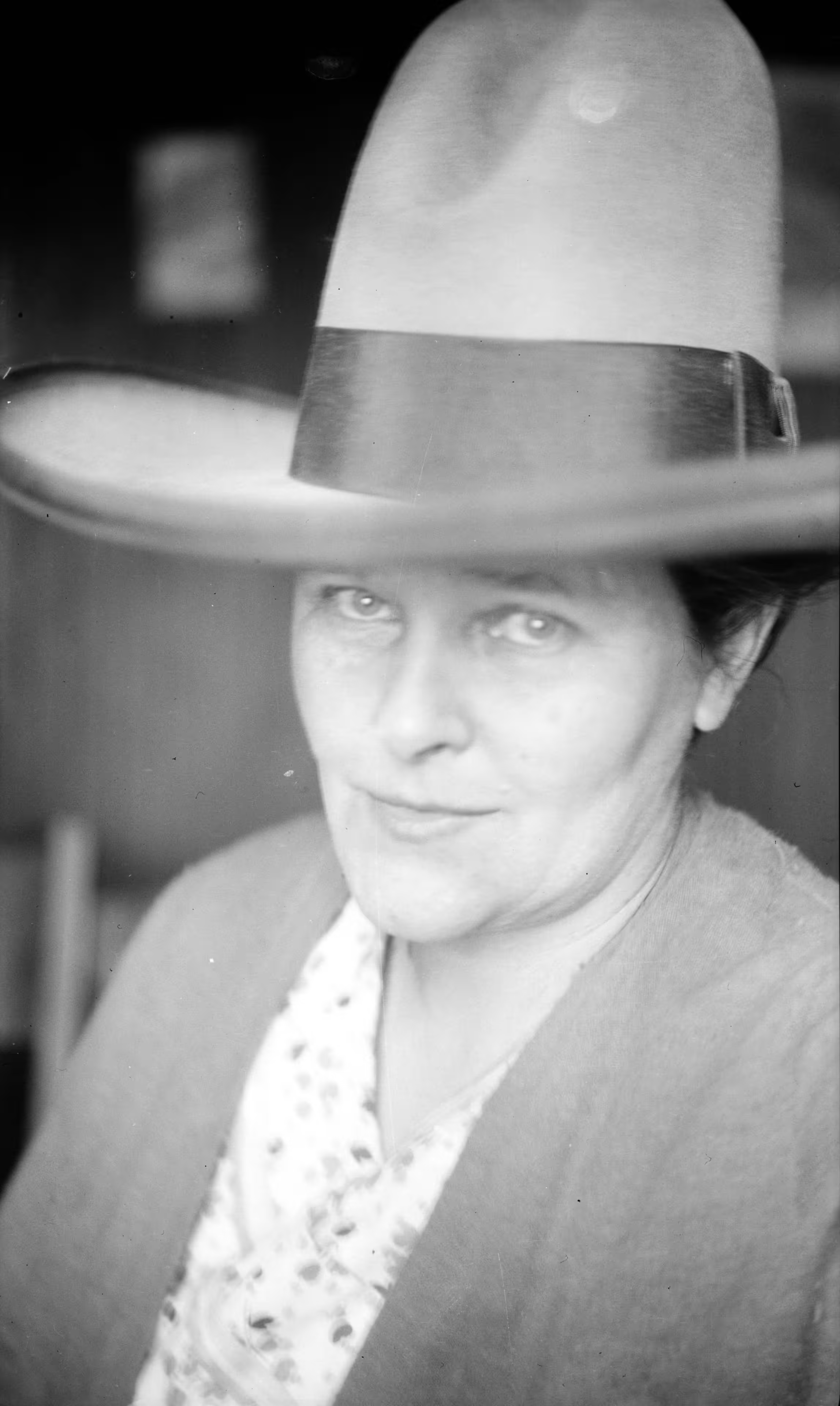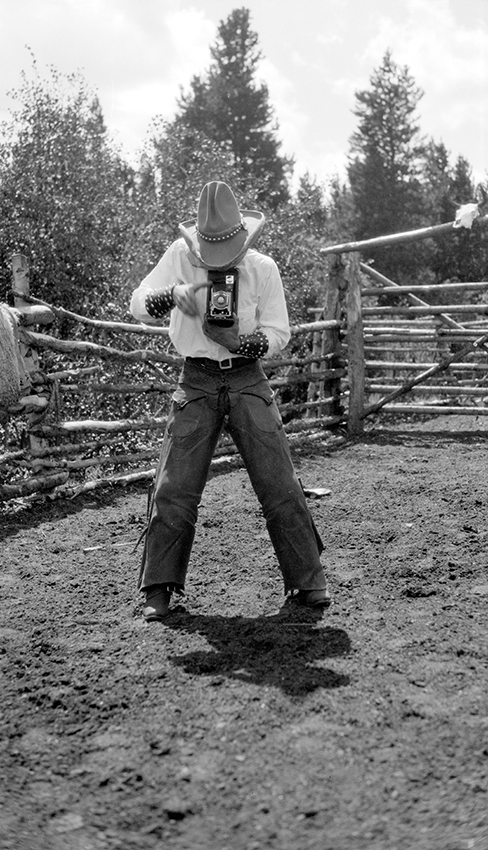I Wish I Was a Yellow Dog
Nearly 24,000 photographs chronicling the lives of pioneer families from the town of Encampment in southern Wyoming have been preserved in the archives of Lora Webb Nichols. This remarkable testimony of a time and place—the early 20th century in the Wild West—has been rescued from oblivion by Nancy Anderson. Set in three different eras and following the lives of three women, the exhibition accompanying the 15th American Film Festival is simultaneously a photo collection, a journalistic report, an archive of letters and diaries, and a historical narrative.
Lora Webb Nichols (1883–1962) and her family arrived in southern Wyoming together with other families in the late 19th century. The pioneers settled in the middle of a vast, wide-open landscape that stretched endlessly to the horizon, with no boundaries. The town of Encampment flourished in the early 20th century because of its copper mines, but Lora’s family ran a farm. Lora began taking photographs when she was sixteen years old and continued to pursue her passion while raising six children in dire poverty. She took photographs both commercially and for her own pleasure, developing them in a darkroom that she set up in her home. Following the decline of the copper industry in the region, she opened her own photography studio after overcoming many obstacles and defying societal norms, called Rocky Mountain Studio, and it became an important hub for the community.
The exhibition presents an overview of Lora’s work from several different perspectives. When photographs that she developed for other people appealed to her, she would keep them for herself and store them in her archive. This principle of looking at things with an outsider’s gaze, and the inspiration that comes from it, can guide us in our approach to this exhibition. Lora’s meticulously catalogued and organised archive was saved by Nancy Anderson, who befriended her towards the end of her life and still lives in her house. Dominika Prejdová ended up in Encampment in 2022 completely by accident, while searching for a petrol station. The fates of Lora, Nancy, and Dominika merged in the surprising way that life sometimes has of bringing people together. Nancy and Dominika selected 250 photographs from the 24,000 negatives in the archive, some of which had been taken by Lora herself, while others were only developed and added by her to the archive. From these 250 photographs, the exhibition’s curator, Łukasz Rusznica, made a final selection.
The exhibition I Wish I Was a Yellow Dog tells the story of three women from different generations meeting in one place, their mutual inspiration, and their continuing gazes—into the depths of their inner selves, into the past, into their own personal narratives, and at each other.
Lora’s world was one of women in corsets living in the middle of nowhere and struggling to survive in difficult conditions. They were often alone in the wilderness while the men worked far away: extracting copper in the mines, felling trees in the mountains, building new roads, and laying railway tracks. Through Lora’s lens, the Wild West is not the world of male power games and unbridled violence familiar to us from pop culture, but rather everyday life captured with an acute attention to detail associated with more contemporary trends in personal photography. The photographs feature people who were close to the photographer in her personal life: her sister Lizzie, husband Guy, mother, friends, and neighbours. These subjects were clearly accustomed to the camera and don’t appear to have been bothered by its presence as they went about their daily activities.

In the male-dominated world of the Wild West, women pursued their passions and desires: they rode horses alone to camp in the mountains, and they ran hotels and other businesses. They relied on each other and overcame loneliness together. In this exhibition of photographs by Lora Webb Nichols, the strong bonds between women take on a new, intergenerational dimension.
Accessibility and sensory information:
- Light – there is daylight and artificial light in the exhibition: led lamps, light from projections (curtain show)
- Sound – You will hear looped sound in the exhibition. Mute headphones are available in the gallery, ask the gallery supervisor for these.
- Viewing the exhibition – You cannot touch the works in the gallery. There are 11 smaller photographs in the exhibition – you can see them up close. Ask the person working in the gallery how to do this. One exhibition room has glass doors and walls. The glass panes are taped with black tape. Take care when entering the room.
- Rest – in the gallery space you will find two benches and some chairs where you can rest. Fabric seating is also available.
- Content – the brochure, the introductory text, the biography of Lora Webb Nichols and the descriptions of the photographs in the biographical section are also available in the binder, in enlarged font, in Polish, English and Ukrainian. There is a chair next to the binder to read the contents comfortably
NOTE: Two photographs will be presented in the exhibition, which contain elements of nudity and expose themes related to corporeality.
- Photographer: Lora Webb Nichols
- Curators: Dominika Prejdová (AFF), Łukasz Rusznica (BWA Wrocław)
- Project concept and texts: Dominika Prejdová
- Selection of photographs and exhibition concept: Łukasz Rusznica
- Preparation for print: Justyna Fedec
- Gallery curator: Joanna Stembalska
- Visual identification: Agata Bartkowiak
- Exhibition trailer: Alicja Kielan
- Sound on display: Jan Duszyński
- Production: Natalia Budzińska
- Promotion: Agata Kalinowska
- Accessibility: Magdalena Weber
- Assembly: Jakub Jakubowicz, Tomasz Koczoń, Marcin Pecyna
- Audience engagement: Daria Chraścina
- Editorial oversight: Joanna Osiewicz-Lorenzutti
- English translation: Scotia Gilroy
- Program BWA Wrocław: Katarzyna Roj
- Fundraising and cooperation with partners: Berenika Nikodemska
- Partners: New Horizons Association, Czech Center Warsaw, Epson
- Media matrons: Final Girls Magazine, Szum Magazine, Radio Wrocław Kultura, Radio RAM
- Organizer: BWA Wrocław Galleries of Contemporary Art
- Co-organizer: American Film Festival
- Special thanks: Nancy Anderson; Grand Encampment Museum, Encampment, Wyoming; American Heritage Center, Laramie, Wyoming



